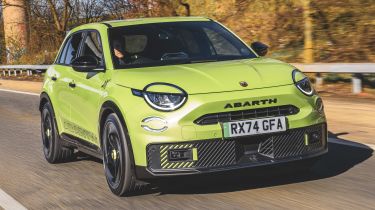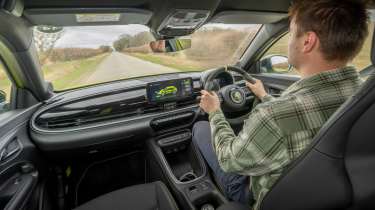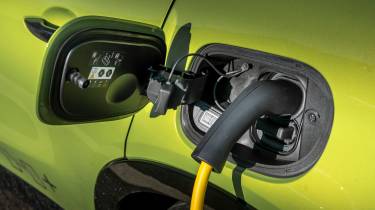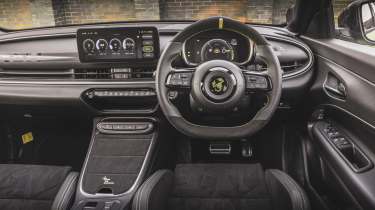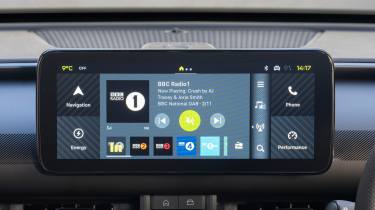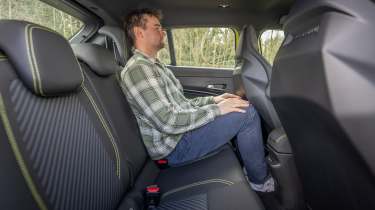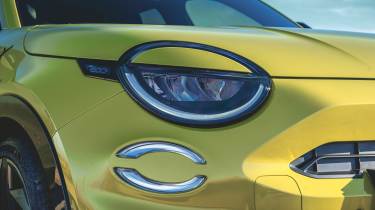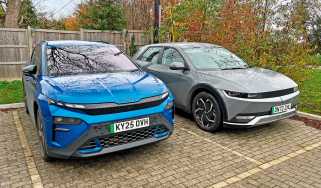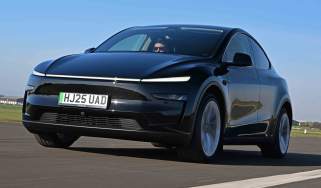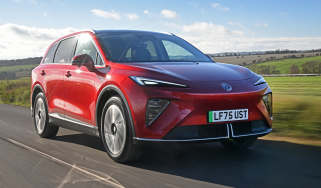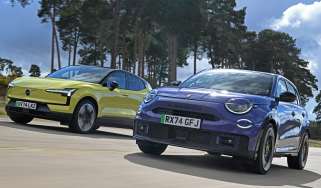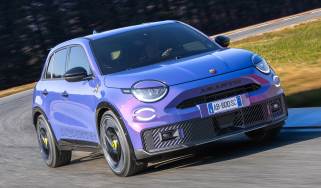Abarth 600e review
The electric Abarth 600e is an interesting alternative to the hot hatch that’s fun to drive and has an unusual design

Our opinion on the Abarth 600e
There’s a lot to like about the all-electric Abarth 600e. A rather brash, somewhat juvenile character is the brand’s modern-day calling card, and the 600e has this in spades, plus there’s just enough performance on offer to warrant its wild and wacky styling cues. Considering the 600e shares its platform and drivetrain with the more mature Alfa Romeo Junior Veloce, Abarth has done well to give it a unique flavour, with a harder-edged ride and more aggressive set-up, although this won’t be to all tastes. Poor range is also a concern, as are – to a lesser extent – the interior quality and overall practicality.
About the Abarth 600e
Abarth has said goodbye to petrol power after 75 years. Fiat’s performance arm kicked off its new electric life with the Abarth 500e, and it followed that up with its most powerful road car ever: the 600e.
It’s based on the Fiat 600e, with both cars using Stellantis’ e-CMP2 platform, so they share parts with the Alfa Romeo Junior, Jeep Avenger, Peugeot E-2008 and Vauxhall Mokka Electric. Abarth calls its version ‘Perfo-eCMP’ thanks to some chassis tweaks and a more powerful motor, which is shared with the top-spec Veloce version of the Alfa Romeo Junior.
Used - available now
A Torsen mechanical limited-slip differential ensures the 600e can cope with the extra power over other e-CMP2 cars. It also gets upgraded brakes and liquid cooling for the battery, plus performance-orientated Michelin Pilot Sport EV tyres. Stiffer suspension and anti-roll bars beef up the chassis for better cornering, too.
There are two models offered, the standard 600e and the more powerful Scorpionissima, which also adds more aggressive styling inside and out.
Abarth 600e prices and latest deals
"The Abarth 600e starts from around £37,000, which is £4,000 more than the highest-spec version of the Fiat 600e. The top-of-the-range Scorpionissima is just shy of £40,000, but Abarth offers assorted deals, including zero per cent finance, plus there is a £1,500 Electric Car Grant (ECG) on offer to help make it more affordable. You can also use the Auto Express Buy A Car service to find the best prices for a 600e currently available from trusted dealers in the UK."
Performance & driving experience
Pros |
|
Cons |
|
Start up the Abarth 600e with the sound generator enabled and it’ll make you smile, because it sounds like a petrol car with a big exhaust when idling. But you’ll stop smiling when you pull away, because the noise becomes a drone, and with no gearchanges, it sounds more like a lawnmower than a sports car. Thankfully, you can turn the generator off.
Many performance EVs are rear-wheel drive (like the Volvo EX30 SUV) or all-wheel drive, but the Abarth is more like a hot hatchback, due to its front-mounted motor. There are driving modes that adjust the performance: Turismo restricts everything for efficiency, Scorpion Street allows the full potential of the motor, and Scorpion Track makes the accelerator pedal more sensitive, adjusts the stability control, and adds a little weight to the steering.
The Abarth’s Torsen limited-slip differential provides a surprising amount of grip on corner exit, but it still can’t deal with full throttle as early as a petrol hot hatch can. On track, the 600e’s stiff suspension and upgraded chassis mean it feels pretty capable and is fun to chuck around.
The brakes are upgraded over a Fiat 600e’s, but there’s not a lot of feel through the pedal. They do a good job of disguising the car’s weight, though. Ultimately, the Abarth is more fun than most electric vehicles, but doesn’t have the lightweight and chuckable nature of the brand’s recent petrol cars; it feels more serious and grown-up.
| Model | Power | 0-62mph | Top speed |
| 600e | 235bhp | 6.2 seconds | 124mph |
| 600e Scorpionissima | 278bhp | 5.9 seconds | 124mph |
Electric motors, 0-60mph acceleration and top speed
The front-mounted motor produces 235bhp in the standard Abarth 600e, or 278bhp in the Scorpionissima version. Given that both have the same 345Nm torque figure, acceleration feels virtually identical, and as with every EV, there’s lots of punch at low speed but it peters out the faster you go.
Town driving, visibility and parking
Visibility is fine in the 600e because the seats are quite high up, and the fast steering means it’s pretty easy to nip around in. However, the large 20-inch alloys, short tyre sidewalls and stiff suspension mean any bumpy sections or potholes are unpleasant. It’s just about on the right side of acceptable at higher speeds, but the firm ride is poor around town.
Country road driving and handling
Out of town, the suspension settles a bit more and sometimes surprises you with how smoothly it can tackle mid-corner bumps. The fast steering and agile chassis mean this is where the Abarth shines; it’s fun to drive and has plenty of performance.
Motorway driving and long-distance comfort
Wind and road noise are noticeable on the motorway, and the firm ride means you’ll often hear thuds as you go over joints in the road or poor sections of asphalt. It’s not unbearably firm at high speed, but the sports seats aren’t ideal for long trips, and we found the Abarth’s efficiency dropped a huge amount at higher speeds.
The Abarth 600e isn’t brimming with feel and feedback, but we like how it doesn’t take itself too seriously. The fake engine noise will divide opinion – some of us loved it, some of us found it really irritating – but if you’re in the latter camp, you can turn it off." - Alex Ingram, Chief reviewer.
Range, charging & running costs
Pros |
|
Cons |
|
The Abarth 600e doesn’t sap its battery too hard around town or on country roads, but high-speed cruising will mean many stops at charging stations. Yet it is still cheaper to run than a similarly quick petrol-powered rival.
Electric range, battery life and charge time
The 600e’s battery has a total capacity of 54kWh, which produces a range of 200 miles (199.5 miles in the Scorpionissima), which is 50 miles fewer than the Fiat 600e. Our average of 2.7 miles per kWh in cool conditions – not very flattering for an EV – meant a real-world range of just 137 miles.
We drove the Abarth on long motorway trips, around town and along normal country roads, and noticed that while efficiency was fine at lower speed – the predicted range on a full charge was close to the official prediction of 200 miles – once we got up to 70mph, the prediction dropped alarmingly.
Drive enthusiastically on track and we would expect the range to be dwindling after just a few laps, and longer trips will need to be planned out carefully because you will have to recharge more often than normal if you mainly drive around town day-to-day.
The Abarth has a maximum charging speed of 100kW, so can be topped up from 20 to 80 per cent in 28 minutes from a DC source. Fully recharging the battery using a standard 7.4kW home wallbox charger will take about eight hours.
| Model | Battery size | Range | Insurance group |
| 600e | 54kWh | 200 miles | 35 |
| 600e Scorpionissima | 54kWh | 200 miles | 36 |
Insurance groups
The 600e sits in groups 35 and 36 for the standard and Scorpionissima models respectively. That’s one group higher than the Alfa Romeo Junior Veloce (which uses the same body and powertrain), although the Scorpionissima is in exactly the same group as the Volvo EX30 in single-motor form.
Tax
When the Abarth 600e was announced in the UK, the range-topping Scorpionissima model was priced at more than £40k – which would have pushed it above the luxury car tax threshold. Abarth quickly amended the price tag to less than £40,000 so owners will only have to pay a first-year rate of £10, with a standard yearly charge after this.
Depreciation
Over the first three years or 36,000 miles of ownership, the 600e is predicted to keep roughly 53 per cent of its original value if you pick the Scorpionissima; the entry-level model should hold on to almost exactly half of its value over the same period.
Interior, design & technology
Pros |
|
Cons |
|
A wild bodykit and bold paint colours help the 600e to stand out, while a large roof spoiler and blocky, blunt-looking bumpers echo the unique look of the brand’s sixties racers. A lot of electric cars use aerodynamic, flat-looking wheels, but the Abarth has motorsport-style 20-inch rims that mimic those on race cars, with hubcaps that look like centre-locks.
Interior and dashboard design
The cabin is a lot less extreme than the exterior, but the suede steering wheel is great to hold, and it feels a lot sportier than a Fiat 600e’s. The sports seats also look smart, although opinion was divided among testers about how comfortable they were to sit in.
The higher-spec Scorpionissima has the slogan ‘mind the scorpion’ dotted around the cabin. It’s hard to tell what the designers meant by that oddly polite phrase, which probably sounds better when English isn’t your first language. Other questionable styling choices include the holes in the backs of the front seats, which will no doubt prove to be hilarious for children who want to prod their parents in the back during journeys.
Materials and build quality
Material quality inside the Abarth 600e is similar to the Fiat version, which is to say it’s okay. There are some nice touches, such as the suede finish for the steering wheel and seats, but the rest of the trim feels disappointing in a car nipping at the £40k mark. Rivals such as the EX30 feel more upmarket in that sense. Build quality isn’t an issue, and there weren’t any rattles, despite the firm suspension.
Infotainment, sat-nav and stereo
Two panels provide your info and entertainment: a seven-inch driver’s display and a 10.25-inch central touchscreen. These are very similar to those in a Fiat 600e but have Abarth graphics, plus pages that show you lap times, how much torque is being sent to the front wheels, and gauges for battery temperature and G-forces.
Wireless Apple CarPlay and Android Auto are useful, because you can just hop in, tap the icon and have all your apps and routes available straight away. The default user interface in the Abarth isn’t as modern-looking as the Volvo’s, but certain features are actually easier to access, thanks to there being a few shortcut buttons, and the main menu has large, easily understood menu sections to flick through. One of the key functions you’ll probably need is the ability to turn off the sound generator, which is quite quick to access once you know where it is.
"To get a rear-view camera, a heated windscreen, sat-nav and cruise control, you have to go for the 600e Scorpionissima model. This version gets this added kit plus extra driver-assistance tech, a wireless smartphone charging pad and the sound generator that mimics the exhaust note of Abarth’s petrol cars." - Alex Ingram, Chief reviewer.
Boot space & practicality
Pros |
|
Cons |
|
The Abarth 600e is classed as a small SUV and isn’t particularly practical; the boot is smaller than most family hatchbacks’ and the interior feels pretty cramped and dark.
Dimensions and size
Dimensions comparison | |||
| Model | Abarth 600e | Nissan Juke | Volvo EX30 |
| Length | 4,187mm | 4,210mm | 4,233mm |
| Width | 1,779mm | 1,800mm | 1,940mm |
| Height | 1,557mm | 1,593mm | 1,555mm |
| Wheelbase | 2,559mm | 2,636mm | 2,650mm |
| Boot space | 360-1,231 litres | 422-1,305 litres | 318-1,000 litres |
If you’re upgrading from an Abarth 500 to a 600, then you won’t be complaining about the amount of space on offer, but overall the 600e is smaller than most small SUV rivals. The Volvo EX30 doesn’t have as much boot space, but offers more passenger space in comparison.
Seats & passenger space
There’s lots of adjustment in the driver’s seat and steering wheel, so people of different shapes and sizes should be able to get comfy. Some taller staff members found the oddly shaped seat backs uncomfortable, but others thought they were fine.
The sports seats compromise rear-seat space, something that was already a little tight in the Fiat 600e. There’s not much foot room, so adults won’t find the back seats very usable. They’re suitable for smaller kids, but anyone back there will find it quite dark.
Boot space
The Abarth’s 360-litre boot space falls short of most family hatchbacks and lots of other small SUVs, but there’s a removable floor and two hooks. The rear seats fold in a 60:40 split for a 1,231-litre capacity, yet they don’t drop completely flat. The Abarth beats the EX30’s 318-litre boot, though.
Jump into the Scorpionissima and the first thing you’ll notice is the pronounced ridge on the backrest of the Sabelt sports seats. It’s an odd sensation, as if the seat is only supporting your spine and nothing else. We never got used to it, and found that while the base of the seat is excellent, some drivers were never comfortable." - Alex Ingram, Chief reviewer.
Reliability & safety
Pros |
|
Cons |
|
Euro NCAP hasn’t tested the Fiat 600e that the Abarth is based on yet. The model also doesn’t appear in the 2025 Driver Power owner satisfaction survey, but parent brand Fiat placed 21st (out of 31) in the best car manufacturer rankings.
The entry-level Abarth 600e has all the most basic safety kit you’d expect in 2025: lane-departure warning, lane-keeping assist, drowsy-driver detection, autonomous emergency braking and parking sensors all around. The Scorpionissima adds advanced tech such as adaptive cruise control with lane centring and traffic-jam assist, blind-spot detection, a rear-view camera and traffic-sign recognition.
It’s not that easy to turn these features off – they default to on – but the menu shortcuts let you get to the relevant section.
The Abarth warranty is three years long by default, and can be extended to up to 10 years or 100,000 miles with servicing at an Abarth dealer. It shows that the brand has confidence in the reliability of its car, which is a good sign.
Servicing costs are about £28 a month with a three-year plan, which is about the same as most of the major manufacturers.
Buying and owning
- Best buy: Abarth 600e Scorpionissima
Before the range-topping Scorpionissima’s price reduction we’d have recommended the base-level 235bhp model. A gap of around £3,000 isn’t insignificant and on the outside at least the two look identical. But we’d pay the premium for some of the Scorpionissima’s extra features, the bump in power and those sportier seats. In keeping with the overall vibe of the Abarth, we’d definitely go for the Hypnotic Purple or Acid Green colours, too.
Abarth 600e alternatives
We tested the Abarth 600e against the Volvo EX30, and the Volvo edged ahead for its greater all-round ability, although it wasn’t quite as fun to drive as the Abarth.
Other hot electric family cars include the Cupra Born VZ and Volkswagen ID.3 GTX, which offer more power, range and cabin space, plus they’re rear-wheel drive. However, both are considerably more expensive, starting from around £45k. The closest match to the Abarth on price is the MG4 XPower, which has 429bhp and all-wheel drive.
There’s also the 600e’s sister car to consider, the Alfa Romeo Junior. We found it was great to drive and has a bespoke interior, plus it’s available with either 154bhp for less than £34,000, or the same 275bhp as the Abarth for just over £42k - nearly the same as the 600e.
Frequently Asked Questions
It’s an interesting alternative to a hot hatch, and the electric powertrain delivers plenty of punch. It looks pretty distinctive, which will appeal to buyers after a car that stands out from the crowd.
Deals on the 600e and alternatives
